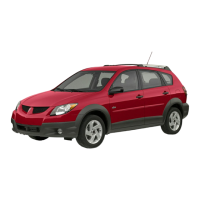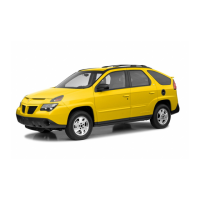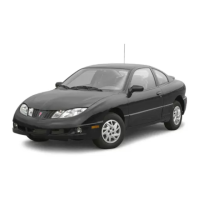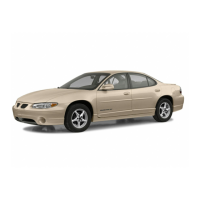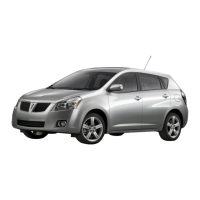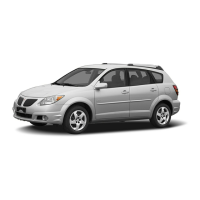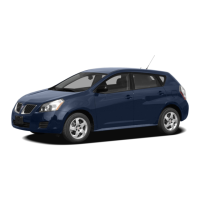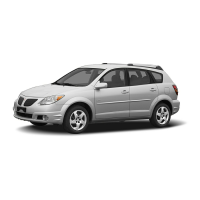
Do you have a question about the Pontiac 2003 Vibe and is the answer not in the manual?
| Brand | Pontiac |
|---|---|
| Model | 2003 Vibe |
| Category | Automobile |
| Language | English |
Explains safety cautions, warning boxes, and symbols like the 'Don't' symbol.
Describes symbols used on the vehicle for components, controls, and indicators.
Information on adjusting seats, reclining seatbacks, head restraints, and folding seatbacks.
Guidance on proper safety belt use and what not to do with safety belts.
Explanation of frontal and side impact Supplemental Restraint Systems (SRS) or air bag systems.
Details on manual and power windows, including AUTO and Lock-Out features.
Information on the vehicle's ignition key and its importance for security.
Explanation of manual, power door locks, and rear door security locks.
How to use the remote keyless entry transmitter to lock/unlock doors and troubleshooting.
Instructions for opening and closing the liftgate/liftglass and safety precautions.
Information on vehicle theft deterrents, key in ignition, parking security, and alarm system.
Explanation of ignition switch positions (LOCK, ACC, ON, START) and engine starting procedures.
Details on shift lever positions (PARK, REVERSE, NEUTRAL, DRIVE, SECOND, LOW).
Explanation of five-speed and six-speed manual transaxle shift patterns.
Chart showing recommended shift speeds for optimal fuel economy and performance.
Instructions on how to set and release the parking brake.
Procedure for shifting into PARK (P) for automatic transaxles.
Safety precautions when leaving the vehicle with the engine running.
Troubleshooting steps if the shift lever is stuck in PARK (P).
Procedures for parking manual transaxle vehicles and parking safety.
Safety warnings regarding carbon monoxide (CO) from engine exhaust.
Precautions and advice for running the engine while the vehicle is parked.
Instructions on how to sound the vehicle's horn.
How to adjust the steering column for driving comfort and entry/exit.
Operation of the turn signal and multifunction lever for signals and lights.
Controls for windshield wipers and washer functions.
Operation, safety precautions, and settings for the cruise control system.
Operation of exterior lamps, including parking, headlamps, and fog lamps.
How the automatic light system controls headlamps based on ambient light.
Functionality and purpose of daytime running lamps.
Controls for interior lighting and instrument panel brightness.
Information on rearview mirrors, including day/night adjustment and reading lamps.
Locations and operation of glove box, door, and instrument panel storage areas.
Using the track system for accessories in the rear cargo area.
Instructions for using the cargo cover and safety precautions.
Using the vehicle's accessory power outlet and electrical equipment precautions.
Information on the 115 VAC power outlet and its limitations.
Proper placement of floor mats to avoid pedal obstruction.
Operation of sunroof tilt and slide functions.
Layout and identification of main components on the instrument panel.
Description of warning lights, gages, and indicators for vehicle functions.
Meaning of the air bag readiness light and system checks.
Function of the charging system indicator light and related issues.
Indicates a problem with the hydraulic brake system.
Warning light for the ABS system and its behavior.
Indicates issues with fuel, ignition, or emission control systems.
Information on passing vehicle emissions inspections and related requirements.
Shows the amount of fuel in the tank and its operational guidelines.
Indicates when the fuel tank is low on fuel.
Overview of the navigation guidance system and its features.
How to operate comfort controls, heating, cooling, and audio systems.
Controls for heating, cooling, and ventilation including mode and fan knobs.
Using the air conditioning system for cooling and dehumidifying.
Optimizing heating and defrosting using recirculation and air modes.
Using the climate control for defogging and defrosting windshields.
Operation of the rear window defogger grid and its precautions.
Directing outside air through the vehicle for mild temperatures.
Operating the audio system for years of listening pleasure.
Instructions for setting the clock on the audio system.
Basic operation of the AM-FM radio, including tuning and seeking stations.
Instructions for inserting, playing, and controlling CDs.
Troubleshooting common error messages displayed by the CD player.
Operation of the six-disc CD changer, including loading and playing discs.
Adjusting bass, treble, midrange, and equalizer settings for optimal sound.
Adjusting sound balance between left/right and front/rear speakers.
Utilizing Radio Data System features like PTY, traffic, and emergency alerts.
How to search for radio stations based on program type (PTY).
Information on driving techniques for various road and weather conditions.
Core advice for safe driving: be ready, expect the unexpected, and maintain distance.
The dangers of alcohol impairment on driving ability and crash risk.
Understanding the vehicle's control systems: brakes, steering, and accelerator.
Explanation of braking action involving perception and reaction time.
How ABS works to prevent braking skids and system checks.
Automatic operation of the AWD system for enhanced traction.
Information on power steering and steering tips for driving on curves.
Procedure for recovering the vehicle if wheels drop off the road edge.
Tips and warnings for safely passing other vehicles on two-lane highways.
Understanding factors leading to loss of vehicle control, including skidding.
Types of skids (braking, steering, acceleration) and how to handle them.
Safety tips for night driving, including visibility and driver impairment.
Precautions for driving on wet surfaces due to reduced traction.
Understanding and avoiding hydroplaning, especially at higher speeds.
Warnings about driving through deep water and potential engine damage.
Strategies for safer driving in city environments with heavy traffic.
Rules and advice for safe driving on freeways and expressways.
Checklist for ensuring the vehicle is ready for a long trip.
Awareness and prevention tips for driver fatigue and 'highway hypnosis'.
Driving considerations for steep hills and mountain roads.
Tips for preparing the vehicle and driving safely in winter conditions.
Techniques for driving safely on slippery surfaces like snow and ice.
Survival tips if stranded in a blizzard, including using the engine and signaling.
Considerations for towing your vehicle behind an RV.
Procedure for dinghy towing front-wheel-drive vehicles with manual transmissions.
Procedure for dolly towing front-wheel-drive vehicles.
Information on vehicle weight capacity and proper loading procedures.
Essential safety rules and tips for towing a trailer with your vehicle.
Rules for selecting and installing correct hitch equipment.
Proper attachment and use of safety chains between vehicle and trailer.
Importance of trailer brakes and integration with vehicle systems.
Experience needed for towing, pre-trip checks, and load security.
Guidance on handling common vehicle issues and emergencies on the road.
How to use hazard warning flashers to alert others and signal problems.
Safe procedures for jump starting a vehicle with a dead battery.
Information on professional towing services and recreational towing.
What to do if the engine overheats, including steam warnings.
Components of the cooling system and safety precautions.
Procedure for adding coolant to the recovery tank and fluid safety.
Steps for safely adding coolant directly to the radiator.
What to expect and do during a tire blowout or slow leak.
Step-by-step guide for safely changing a flat tire.
Proper procedures for storing the flat tire and changing tools.
Information on the compact spare tire, its pressure, and usage restrictions.
Methods for freeing a stuck vehicle, with warnings about wheel spin.
Technique for rocking the vehicle to free it from being stuck.
How to use the vehicle's recovery hook for pulling.
Information on vehicle care, fuel, fluid checks, and appearance.
Importance of using genuine GM parts and dealer service.
Advice for performing self-service, including air bag system precautions.
Information on fuel type, VIN, and checking fuel filler cap.
Recommended octane levels for different engine types and potential issues.
Specific fuel requirements for vehicles certified for California emissions standards.
Safety precautions for refueling the vehicle and handling fuel vapor.
Overview of engine compartment components and safety warnings.
Checking and adding engine oil, including oil pressure light indicators.
Guidelines for selecting engine oil based on API certification and viscosity.
Procedure for checking and replacing the engine air cleaner filter.
Location and replacement procedure for the cabin air filter.
When to check/change transaxle fluid and how to check the level.
Checking and adding manual transaxle fluid procedures.
Information on the hydraulic clutch system and fluid level checks.
Lubricant checks for transfer case and rear differential on AWD vehicles.
Explanation of the cooling system and coolant mixture requirements.
Importance of the radiator pressure cap and its proper installation.
When to check power steering fluid and how to check the level.
What to use for windshield washer fluid and adding washer fluid.
Information on brake fluid level and potential issues.
Identifying worn brake pads and related noises.
Information on the maintenance-free ACDelco battery and warnings.
Procedure for storing the vehicle for 25 days or more, including battery care.
General guidance for replacing vehicle bulbs and halogen bulb safety.
Procedure for replacing headlamp bulbs.
Procedure for replacing front turn signal lamp bulbs.
Procedure for replacing turn signal and brake lamp bulbs.
Procedure for replacing back-up lamp bulbs.
Procedure for replacing the center high-mounted stoplamp bulb.
Inspection and replacement of windshield wiper blades.
Information on tire maintenance, inflation, wear, and dangers.
Explanation of treadwear, traction, and temperature grades for tires.
Guidelines for replacing wheels and using correct replacement parts.
Precautions and guidelines for using tire chains and traction devices.
General advice on cleaning vehicle surfaces and product safety.
Tips and procedures for cleaning fabric and carpet interiors.
How to clean and care for vinyl interior surfaces.
Proper methods for cleaning and maintaining leather interior surfaces.
Cleaning exterior glass, backglass, and wiper blades for clear visibility.
Best practices for washing the vehicle to preserve paint finish.
How to clean aluminum wheels safely without causing damage.
Using tire cleaner and dressing with care to avoid vehicle damage.
Ensuring proper anti-corrosion treatment during sheet metal repairs.
Precautions and information regarding add-on electrical equipment.
Protecting wiring circuits with fuses and circuit breakers.
Location and diagram of the engine compartment fuse block.
List of replacement bulb numbers for various vehicle lamps.
Approximate fluid capacities for engine, transmission, and other systems.
Overview of required vehicle maintenance for safety and performance.
Explains what services to have done and when, based on driving conditions.
Conditions defining short trip/city driving for maintenance scheduling.
Recommended maintenance intervals for short trip/city driving conditions.
Conditions defining long trip/highway driving for maintenance scheduling.
Recommended maintenance intervals for long trip/highway driving conditions.
Owner checks and services to ensure vehicle safety and performance.
Underhood checks recommended at each fuel fill.
Procedure for checking and adding engine oil.
Procedure for checking and adding engine coolant.
Procedure for checking and adding windshield washer fluid.
Checking the primary and secondary hood latches for proper operation.
Regular checks to perform on tires and restraint systems.
Checks for restraint systems, wiper blades, and weatherstrips.
Checking power steering and transaxle fluid levels.
Procedure for checking the starter switch and its safety precautions.
Checking the shift lock control system for proper function.
Checking parking brake and automatic transaxle PARK mechanism holding ability.
Inspections to be performed at least twice a year by a service center.
Inspecting steering, suspension, and axle components for wear or damage.
Checking the exhaust system for damage, leaks, or loose connections.
Inspecting the complete fuel system for damage or leaks.
Inspecting cooling system hoses, pipes, fittings, and pressure cap.
Inspecting brake lines, pads, rotors, linings, drums, and parking brake.
List of recommended fluids and lubricants by name, part number, or specification.
Section to record service dates, odometer readings, and performed maintenance.
Information on contacting Pontiac for assistance and reporting safety defects.
Steps for resolving concerns with dealerships and Pontiac customer assistance.
Information on the out-of-court dispute resolution program with BBB Auto Line.
Contact information for deaf, hard of hearing, or speech-impaired customers.
Contact details for customer assistance in the U.S., Canada, and overseas.
Program details for reimbursing adaptive equipment and providing resource information.
Overview of Pontiac's Roadside Assistance program and included services.
Customer support program offering transportation options during warranty repairs.
How to report vehicle safety defects to NHTSA and General Motors.
How to report vehicle safety defects to Transport Canada and General Motors.
Information on ordering service manuals, bulletins, and owner publications.
